Deep in the ocean, mysterious artifacts sink from the world above. Adorable octopuses compete for the best collection of Fallen Treasures.
What Is Fallen Treasures?
Fallen Treasures is a trick-taking game from CardLords for 2 to 6 players, ages 7 and up, and takes about 10 minutes to play. It’s currently seeking funding on Kickstarter, with a pledge level of $12 for a copy of the game. The game is pretty easy to learn and definitely suitable for kids, but adults who like trick-taking games may also enjoy it.
New to Kickstarter? Check out our crowdfunding primer, and visit our Kickstarter curated page for more projects we love.

Fallen Treasures Components
Note: My review is based on a prototype copy, so it is subject to change and may not reflect final component quality.
The game components are pretty simple: 18 Octopus cards (3 per player color) and 60(ish) Treasure cards. (My copy had 63, which included 3 bonus treasures, but I suppose things may change depending on stretch goals.
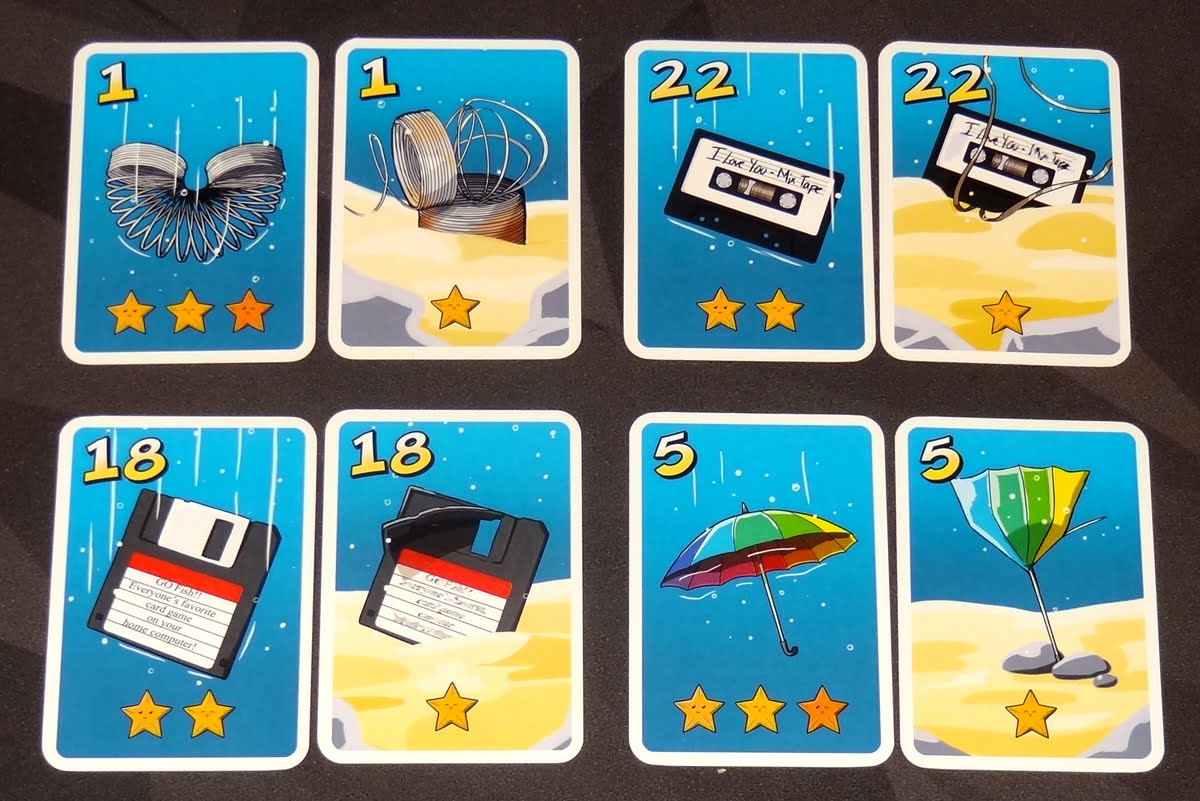
The treasure cards are wonderfully illustrated, a collection of random junk from lava lamps to skateboards to watches. The cards are numbered from 1 to 30, with two copies of each number. One version shows the item in pretty good condition still sinking in the water, and the other version shows it down in the sand, damaged in some way. The good version is worth 2 or 3 stars, and the broken version is worth 1 star. There are lots of fun little details in these illustrations, and we enjoyed comparing the two versions of the treasures.

The octopus cards are simply adorable. Each card shows a swimming octopus on one side and a sleeping octopus on the back, and every player gets three copies of their chosen octopus.
The whole thing will come in a plastic tuckbox, similar to some of CardLords’ previous titles like BattleGoats and Take the Gold. It’s a nice, sturdy box with a flip-top lid, and it’s waterproof—though perhaps not watertight, so don’t submerge it or anything or it’ll only be worth 1 star.
How to Play Fallen Treasures
You can download a copy of the rulebook draft here.
The Goal
The goal of the game is to collect the most stars on treasures by the end of the game.
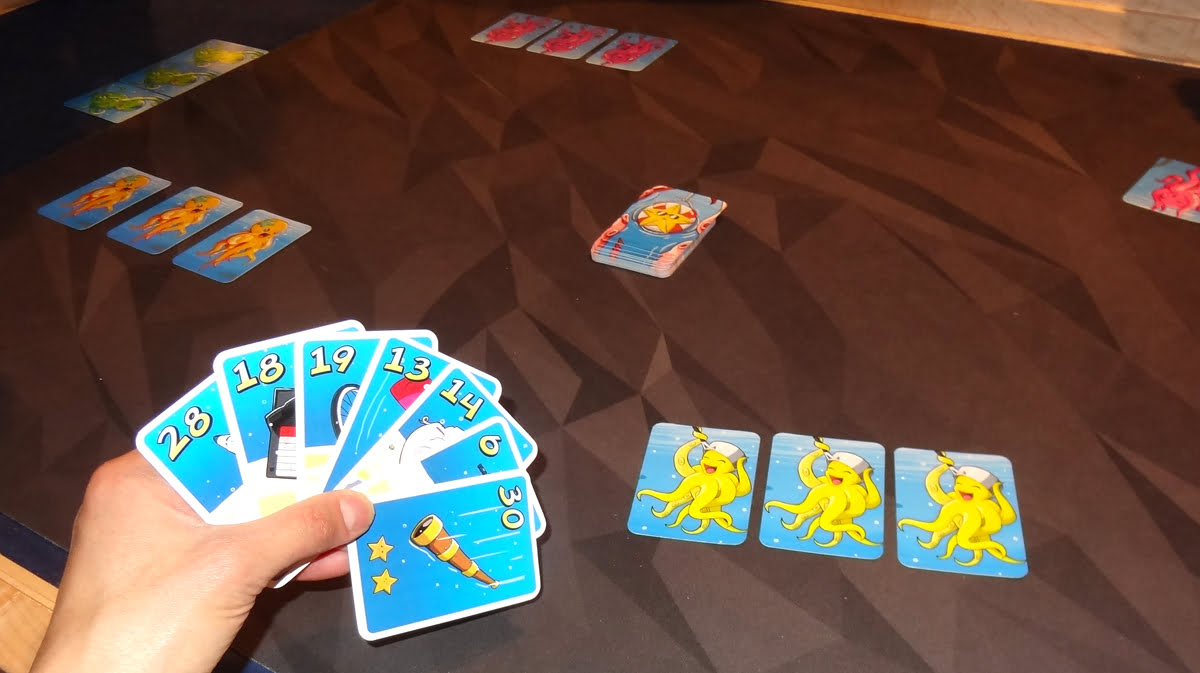
Setup
Give every player 3 octopus cards, which are placed awake-side-up in front of them. Shuffle the treasure cards and deal a hand to each player—the number of cards in a hand (and number of rounds in the game) depends on the player count. Set the deck in the center of the table. The player with the longest arms starts.
Gameplay
During each round, each player will play one card, beginning with the start player and going clockwise. You may either play a treasure card or play one of your octopus cards, flipping it over to the sleeping side.
If nobody plays an octopus, the player with the highest numbered treasure wins the round and takes all of the treasures. (In case of a tie, the card with more stars wins.)
If only one player plays an octopus, that player takes all of the treasure cards.
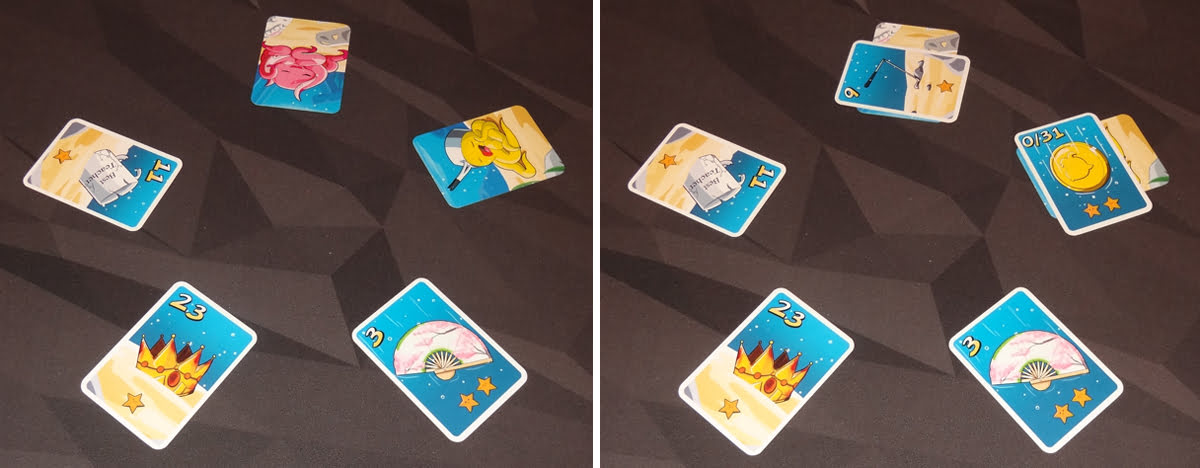
If, however, at least two players play octopus cards, then there’s a tangle!
First, each player who tangled chooses a card from their hand and places it face-down on their octopus, and then the cards are all revealed.
Going from the lowest card to the highest card, each player in the tangle must draw one card from the deck and place it on the card from their hand. If the card is higher than their played card, they’re still in the tangle. If the card is lower, then they bust and are out of the tangle—but their treasures are still part of the pot. If everyone involved in the tangle busts, then the non-tangled player with the highest number takes all the treasures (including the ones from the tangled players).
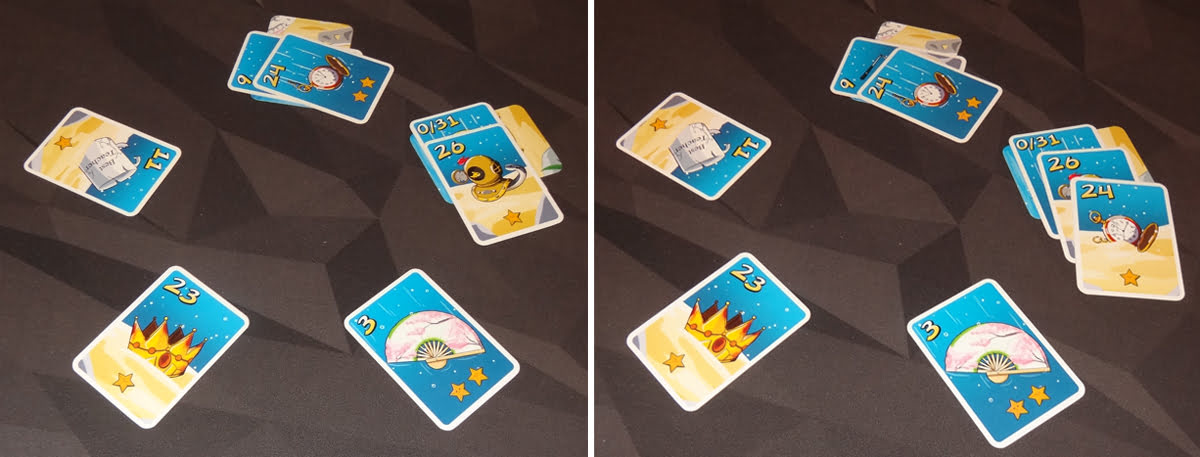
Otherwise, the tangled players continue until there is only one person left in the tangle, using the same turn order. On subsequent turns, you may choose either to take your chances and draw another card—which must be higher than the last card in your stack—or you can leave the tangle, in which case you get all of the cards on your octopus but not the ones played by other players.
When there is only one player left in the tangle, they collect all remaining treasures.
In the case that all players were tangled and all of them bust on their first draw, the treasures are all lost at sea and nobody gets anything.
For the next round, starting player passes to the left.
Game End
The game ends after the specified number of rounds. The player with the most stars in their treasure collection wins!
Two-Player Rules
For a 2-player game, you also deal out a full hand to the Ghost Fish, which will randomly play a card each round. The Ghost Fish does not play octopus cards, but can still win in a tangle if both players bust.

Why You Should Play Fallen Treasures
Fallen Treasures is a pretty simple, quick-playing twist on trick-taking, but don’t let its simplicity fool you—there are some hidden depths to this game. The default “highest number wins” condition is easy enough to understand—you in that case, you try to beat the other players if you can, or else dump a card if you can’t. The small twist there is that in many trick-taking games you’re often sloughing low cards because they won’t help you win future tricks, but here you have two other considerations. First, lower cards aren’t necessarily worth fewer points, because you might have a low card that’s worth 3 stars—definitely not something you just want to throw away. Second, low cards are better when you get into a tangle, since you’ll be trying to draw a card higher than the one you play.
If you can use your octopus at just the right moment, then you might be able to use it to win a trick without tangling. This usually only occurs if you’re the last player in a round, though, because players who go after you’ve played an octopus know they’re just sloughing cards that won’t win. So unless you’re the last player, you’re probably not going to get a lot of stars with your octopus.
The tangles, of course, are where the game really gets interesting. What card do you play on your octopus during a tangle? Everyone has to draw at least one card, so you don’t want to play something too high, or you may simply bust and give away both your card and the one you drew. But you also have to consider whether to play a card with more stars or fewer stars. If you can survive the first draw but you have a lot of stars, it may be a good move to withdraw from the tangle, keeping the guaranteed stars (and depriving the tangle winner). If you don’t have a lot of stars, you may want to stay in the tangle longer for a chance to win the whole pot. I like the way that the tangle gets harder and harder, because you have to keep drawing higher and higher cards.
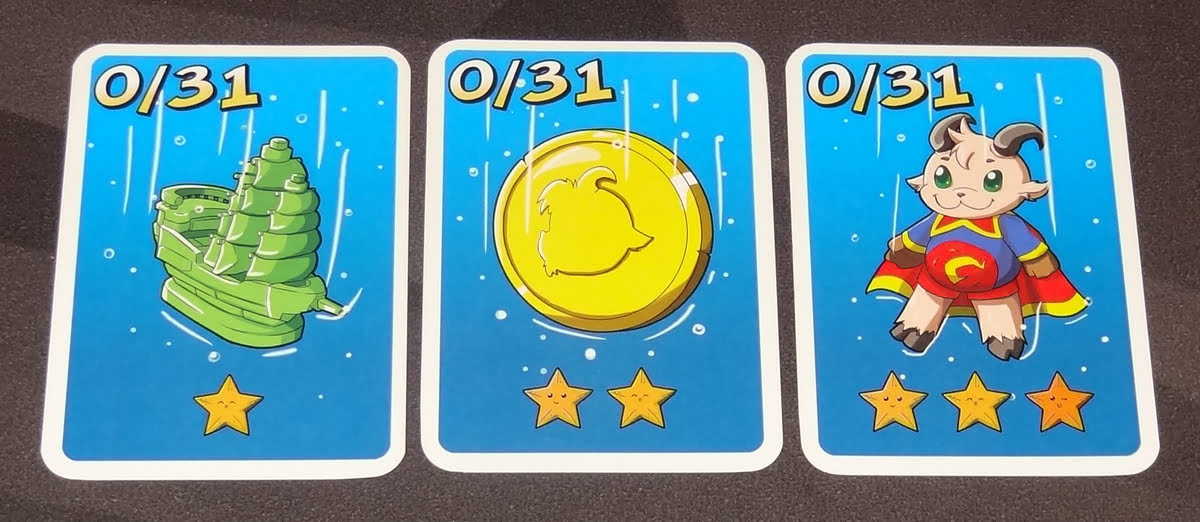
The bonus treasures can be used as a 0 or a 31, which gives you some great flexibility. If you play one during a trick, you can declare it as a 31 to win the trick (assuming there are no octopus cards played). If you play it as your card during a tangle, you can declare it as a 0, making your first draw safe. And if you draw it during a tangle, you can declare it as a 31, ensuring that you don’t bust … but then, of course, you’ll have to withdraw on your next turn because you won’t be able to beat it. (If you’re familiar with the CardLords’ previous titles, you’ll recognize BattleGoats, Take the Gold, and The Pirate’s Flag represented on the bonus cards.)
Since unused octopus cards aren’t worth anything at the end of the game, you’re incentivized to use them. In a 6-player game, there are only 5 rounds, so you may be playing octopus cards more often than treasure cards—which also means that the likelihood of a tangle is pretty high. It’s also fun to lead the trick with an octopus, just to see how the other players respond—who’s willing to spend an octopus on a completely unknown amount of treasure?
There is a pretty high luck factor involved, both in the cards you’re dealt and in the cards you draw during a tangle. It seems that high cards are valuable for winning tricks and low cards are valuable for surviving tangles, but being dealt a hand of mid-range cards may put you at a disadvantage. Playing a low card in a tangle may all but guarantee that you’re safe on the initial draw, but if you draw a high card then it doesn’t help you survive subsequent rounds. So although there is some strategy to the gameplay, your carefully crafted plans can sometimes be thwarted by bad luck.
When I played with my adult friends, many of us enjoyed it but felt that it might be more fun to play a few rounds and total scores, since that often helps balance out the luck a little. I considered drafting starting hands, but I’m not sure that in a game this quick it’s worth making it into a drafting game as well. Ultimately I think it works fine as is, as long as your group has the expectations that it’s a light trick-taking game and not a heavily strategic one.
We’ve enjoyed playing Fallen Treasures, and I think it’s particularly fun with more players simply because the tangles are fun to resolve, and they’re more likely to happen when you have more players. For more information or to make a pledge, visit the Fallen Treasures Kickstarter page!
Click here to see all our tabletop game reviews.
![]() To subscribe to GeekDad’s tabletop gaming coverage, please copy this link and add it to your RSS reader.
To subscribe to GeekDad’s tabletop gaming coverage, please copy this link and add it to your RSS reader.
Disclosure: GeekDad received a copy of this game for review purposes.





